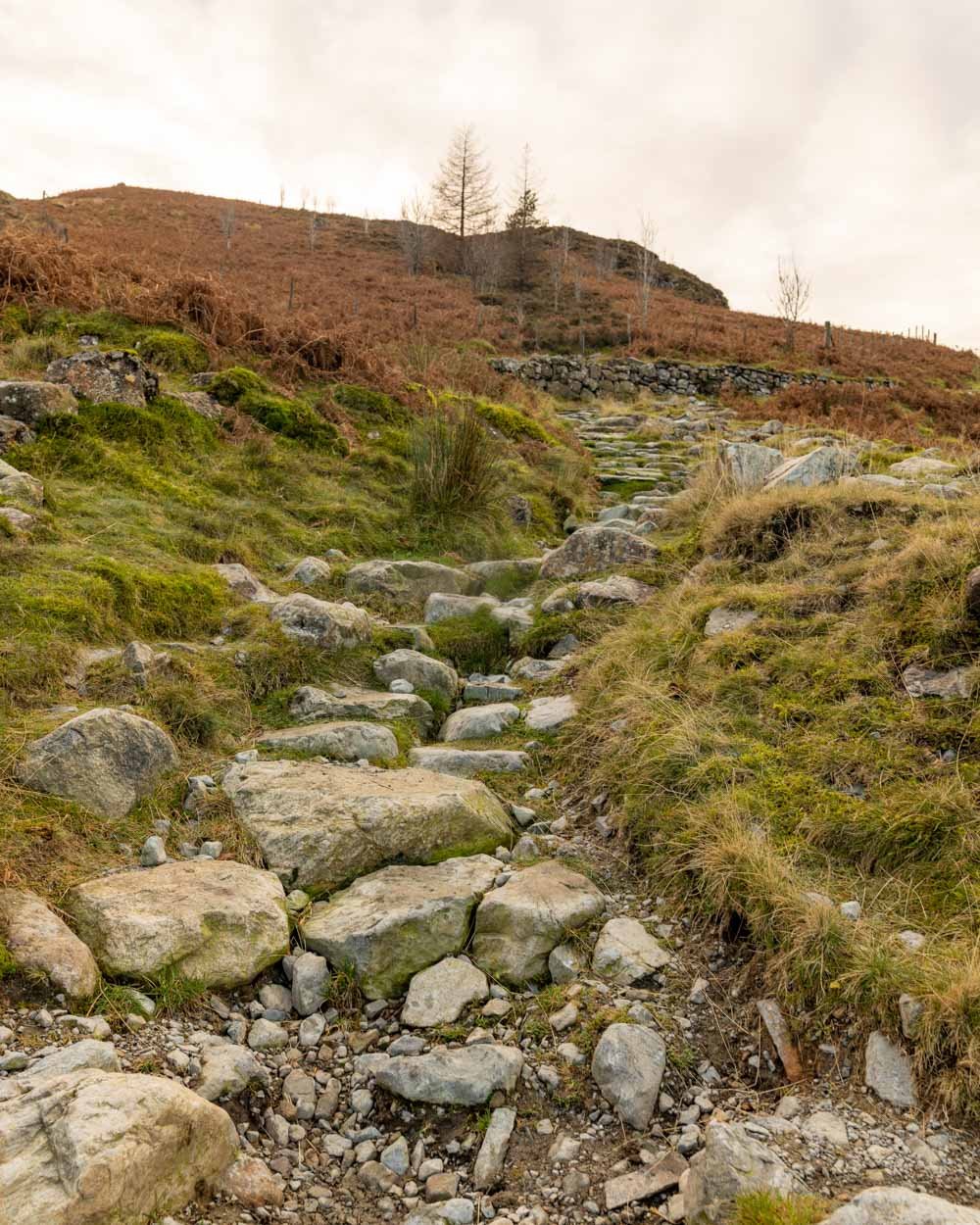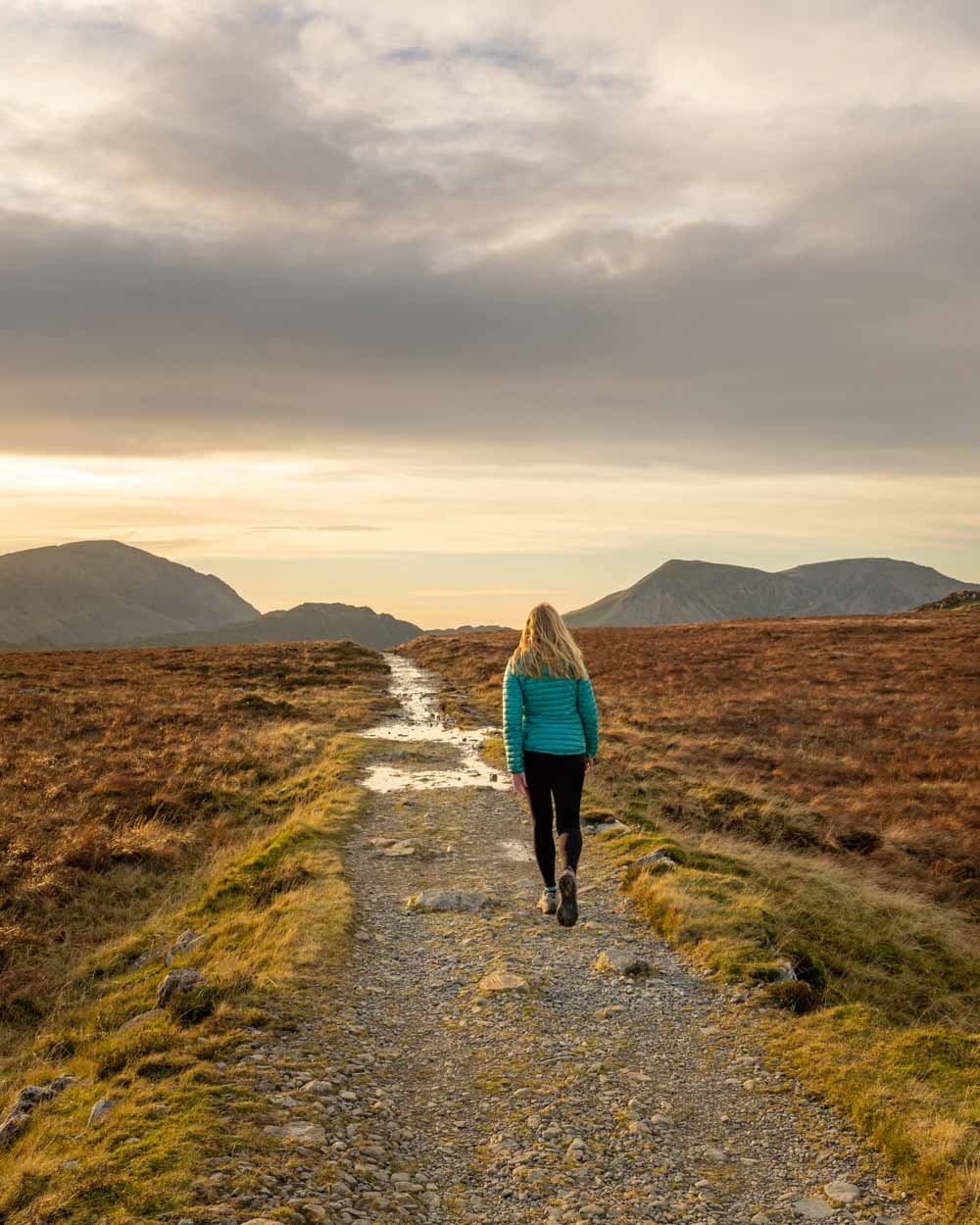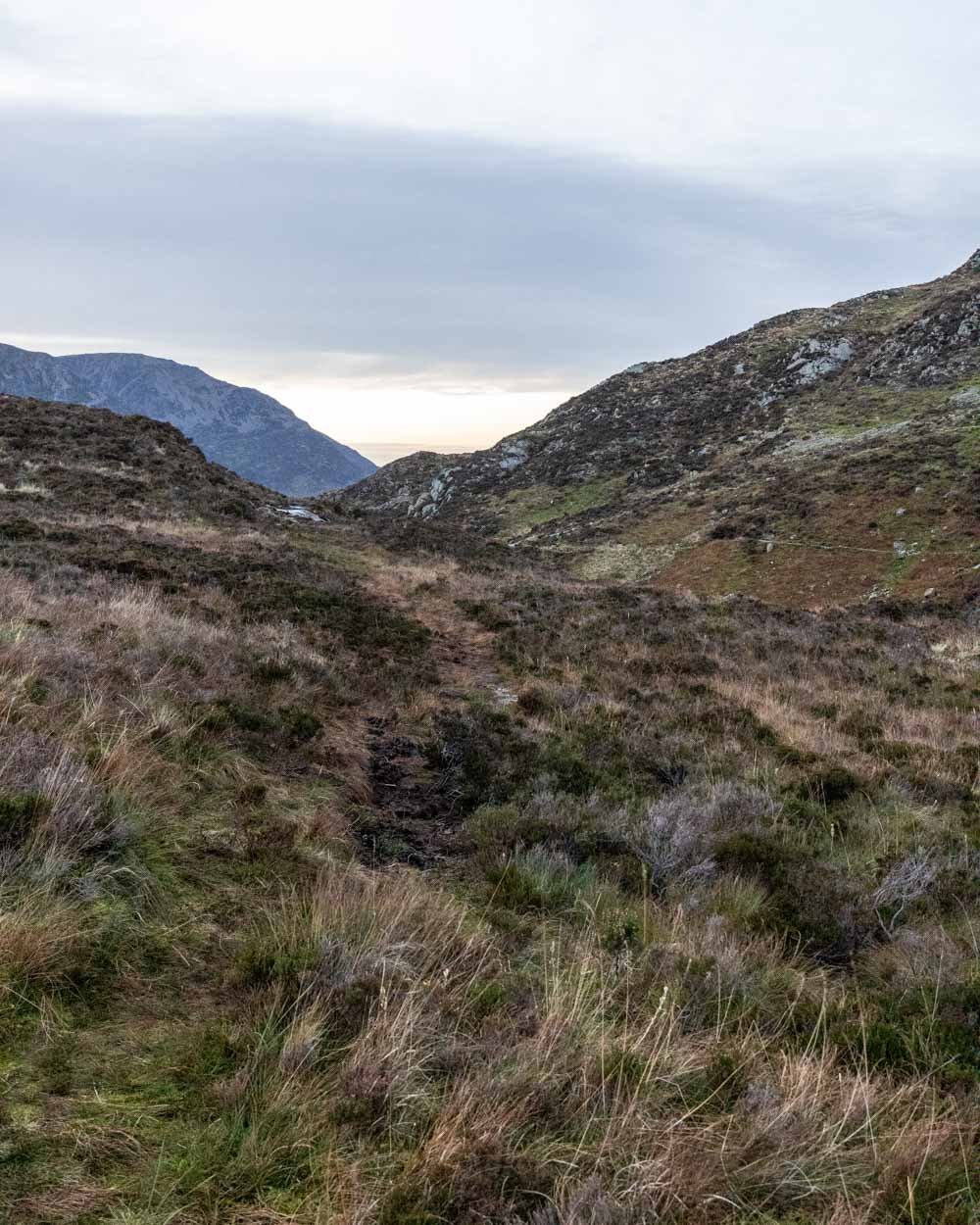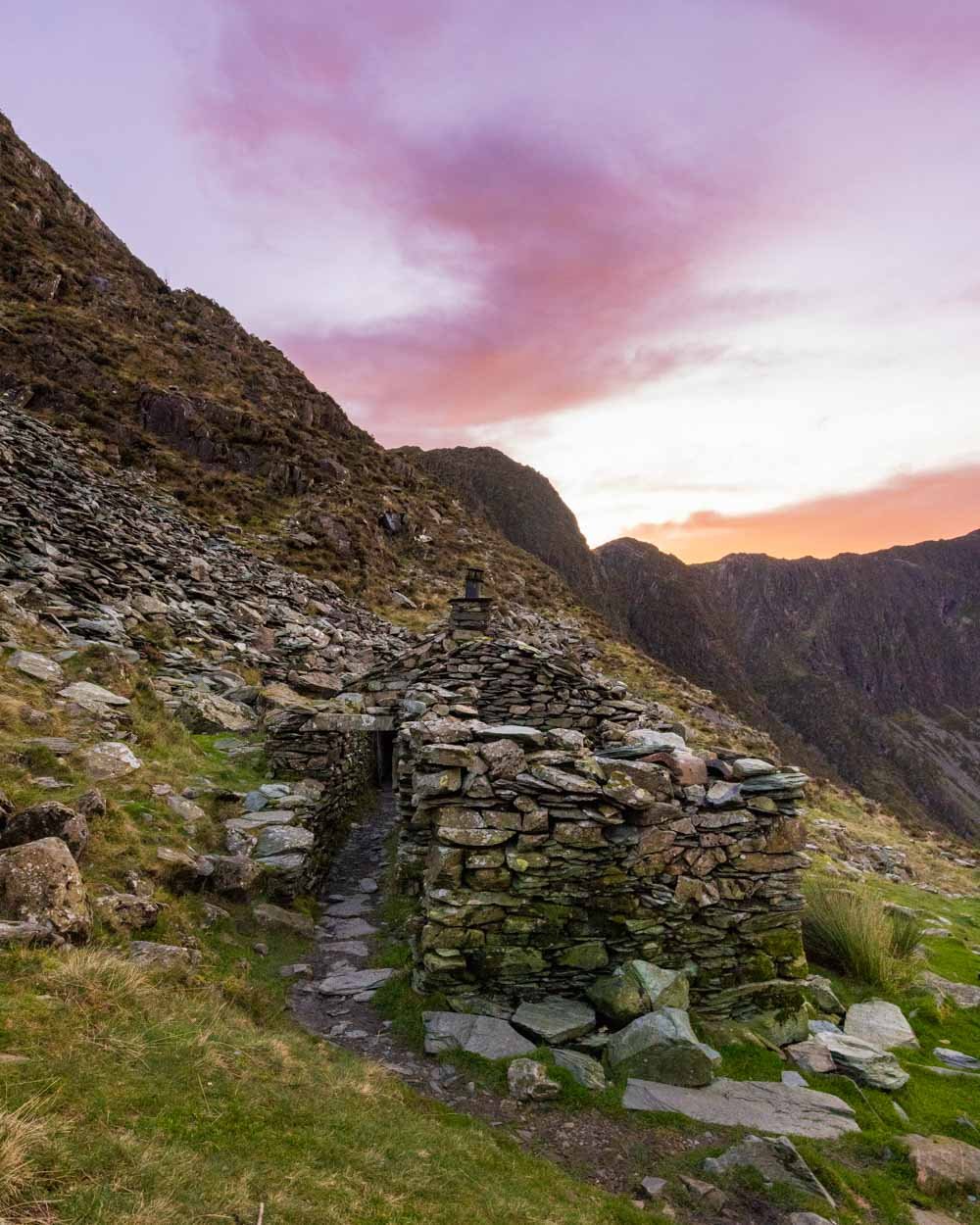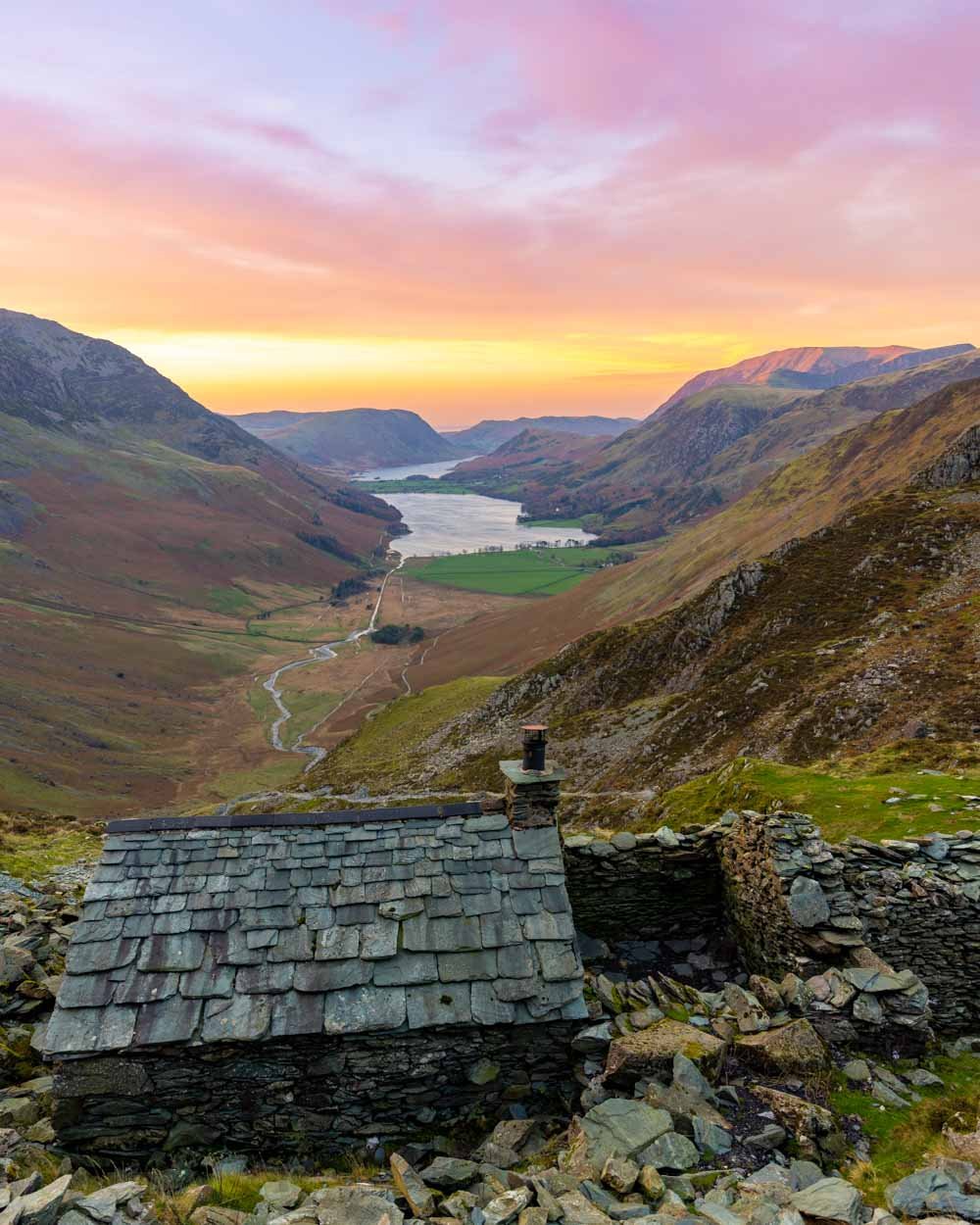Perfectly camouflaged at the bottom of a big pile of slate, and nestled on the edge of a cliff with seriously incredible views, Warnscale Bothy makes for one of the most evocative scenes in the Lake District. It’s a magical spot, made all the more special by the fact you are still allowed to use the bothy today. It might be very rustic, but the views and setting are five star all the way.
It’s not easy to find, but that’s what makes it extra special when you do. Even the walk to get there is beautiful, passing another easier access hut along the way.
Here’s how to find the very well hidden Warnscale Bothy.
Please leave it pristine
The beauty of places like Warnscale Bothy is that it’s free for everyone to use, and each person leaves it as they would hope to find it. You’ll even see boxes of matches and condiments left for the next guests to enjoy.
This relies on each person respecting the bothy and taking all rubbish with them. We’ve seen beautiful little places like this closed due to the odd person not looking after it. Please look after this Lake District treasure and keep it open for generations to come.
The walk to Warnscale Bothy
The stats
Distance: 1.5 miles (2.5km) each way
Elevation gain: 360m
Difficulty: Moderate
The walk to Warnscale Bothy has one significant climb at the start, which is on a well maintained track. Reaching the bothy itself does require walking off track and traversing some rocky and boggy terrain. There is also one river crossing required to reach it. There are rocks to use as stepping stones, but after very heavy rain they may become submerged.
The trail passes another mountain hut, Dubs Hut. Reaching it is all on a well maintained track and doesn’t require negotiating any bog, or the river crossing. It’s a good option if you want to see one of the old bothies, but don’t like the sound of the off track section.
Where to park for Warnscale Bothy
There are two car parks a few minutes walk apart which can be used for accessing the trailhead to Warnscale Bothy. The first, which is a couple of minutes further away from the trailhead, is the National Trust Honister Pass car park, postcode CA12 5XN. It costs £5 per day for parking - exactly the same as the one fractionally closer to the trail, run by the Honister Slate Mine.
The difference will be if you’re a National Trust member, as then you are able to use the Honister Pass car park for free, which is what we did.
If you’re not, you may as well park a touch closer at the slate mine.
Starting the trail: the climb
From the Honister Slate Mine car park, you need to head up the gravel road to the left of the car park (heading in a northwest direction) when facing away from the buildings.
After just 65m you’ll see a path leading on to the hillside on your left, signposted as Great Gable and Haystacks.
The next 240m are quite steep and on a mix of large stone steps, and then the smaller cobblestones that you often find on trails in the Lakes.
After this, the next 550m are still uphill, but the gradient is much more gentle. The path is still rocky for a fair amount of the way, but it doesn’t take too long before you reach a flatter path.
To Dubs Hut
At the 850m mark the gradient slackens so much as to pretty much feel flat. You’ll be walking on a stony track (but much smoother than it’s been up to now) with wonderful views out over the fells.
The closer you get to Dubs Hut, the more Haystacks appears to loom over you.
After roughly 400m along the flat path you’ll come to a little narrow section through a slate pile, Dubs Hut is now just 130m ahead of you (just under 1.3km into the walk).
It’s in a very picturesque spot and is easy to access, which makes it a great place to aim for if you’re not too sure about going off trail.
Exploring Dubs Hut
Like most mountain bothies, Dubs Hut is a basic stone shelter, it’s allure is its fabulous location.
Inside you’ll find two wooden sleeping platforms (big enough for one person on each) a fireplace, a few camp and normal chairs, a washing line and a variety of little odds and sods left by previous guests.
You’ll want to bring everything you need to cook, light the fire (including wood) and sleeping bags etc with you. Essentially think of it as camping, but with a proper roof over your head. There’s a water source outside, but no toilet facilities.
You may find things like matches at the bothy, but just incase, bring your own. Though it’s not a long walk back, it’s a remote area, so it would take a long time to get to somewhere you can buy them.
We started using mountain huts in New Zealand, where the code is basically to leave the hut better than you found it.
This means things like sweeping the floors and leaving some wood for the next guests. I am not sure what the etiquette is for the Lake District, but I am sure it’s something very similar.
At time of writing, you can’t book a bed in the bothy; it’s first come first served, so it’s best to bring a tent as well just incase you find it occupied. Unlike Warnscale Bothy, there is quite a bit of floor space, so if you have a very good sleeping mat that might also do, but beware: the stone floors do get very cold!
Onto Warnscale Bothy: crossing the river
It’s just 700m from Dubs Hut to Warnscale Bothy, but it may take a little longer than you think. We are going to do our best to describe the route, but it is slightly harder to describe than most due to a number of well trodden side trails which can be distracting.
From Dubs Hut you continue on the main trail heading downhill. To the left, down a very rocky path, you’ll see the river - Warnscale Beck.
Head towards the river. This bit is a little steep and the rocks can be a touch slippery when wet. It’s only 200m between Dubs Hut and the river crossing though.
There are two distinct sets of rocks that you can use as stepping stones to cross the river. Depending on the height of the river (don’t cross if it’s in flood) this will either be a simple case of rock hopping, or slightly more precarious, as the semi submerged rocks can be slippery.
The second set of stepping stones to the left were the most exposed for us, so we used those. It is quite easy, but the rocks do move a bit and are slippery in places, so just take it slowly.
Locating the bothy
After you’ve crossed the river, the path may become a bit boggy. We were visiting in November after several weeks heavy rain, so during a dry spell it may be less so, but come prepared for some long muddy patches, and then you can only be pleasantly surprised if it’s dry!
Navigating the next part of the trail will determine how easily you’ll locate the bothy. The easiest route is to take the path on the right 70m from the river crossing.
It looks counter-intuitive because it’s a narrow wet muddy path, when there’s a perfectly good gravel path ahead of you. We took the gravel path on the way and though it will take you to the bothy, it was significantly harder to follow and harder to see the bothy from than if you walk via the lower wet path we returned on.
Take the narrow grassy track, which again is boggy, and keep following it, you are just 450m away from the bothy when you make this turn. You will be walking close to the river for much of the way, always with it on your right.
The path will begin to bear left and you’ll reach a rocky patch of track heading downhill. Check your coordinates at this point (54.5086477, -3.2297364) in order to get a rough idea where you’re heading.
You should hear the sound of a waterfall and start to get views of Crummock Water in the distance.
You’ll see the bothy located at the bottom of a large slate pile, across a rocky stretch of grass, opposite the waterfall.
It’s nicely camouflaged when viewed from above, but using the lower path we’ve described, you will see it.
Exploring Warnscale Bothy
Dubs Hut is nice, but Warnscale Bothy really is a picture perfect little stone shelter. Again it’s very basic, but the views are just out of this world, especially in the soft light of sunset.
You’ll see the little stone hut nestled into the slate pile, overlooking Haystacks, Crummock Water and Buttermere. It’s a jaw dropping view, especially if you climb slightly up the slate pile behind the hut for an elevated vista.
Inside the bothy there is a window which perfectly frames the scene, and it really is very special that you can get a view like this without having to spend a dime.
The bothy is smaller than Dubs Hut, with the same sleeping benches, but much less floor space. At time of writing there are two sleeping mats in there, one is very thin and one is more like a slim mattress - but I wouldn’t necessarily assume they will always be there.
There’s a good sized fireplace which - with the small space - should keep it nice and toasty on cool evenings. As with Dubs Hut, I would bring everything with you.
There were matches and some random things like condiments left when we visited, but you can’t be sure. There was also a frying pan and a string of battery operated fairy lights, which I found incredibly charming.
There are no toilet facilities and water must be obtained from the nearby river. As there isn’t much space at the bothy, again it would be a good idea to have a backup plan if you find it full.
There’s a guestbook and pen in the hut and I loved having a flick through and hearing the tales of previous adventures here.
On leaving the bothy, we retraced our steps, but if you have a map with you, there are other trails to enjoy in the area.
Getting to the parking area for Warnscale Bothy
As mentioned above there are two car parks for accessing Warnscale Bothy via the quickest route we took. The first is run by the National Trust and the second by the Honister Slate Mine. I noticed that if you park at the Honister Slate Mine overnight the fee increases from £5 to £15.
We had a National Trust membership card, so we didn’t pay to stay in their car park, and I didn’t notice if the fee also increases if you stay overnight. Hopefully not!
The road to both car parks can be narrow in places - much like many other parts of the Lakes, so the journey may take longer than you expect. It’s just under 3.5 miles from Buttermere, 9 miles from Keswick and 26 miles from Ambleside.
This post may contain affiliate links, meaning at no additional cost to you, that we will earn a small commission if you click through and decide to make a purchase. This helps towards the costs of running our website. Thanks for your support.





